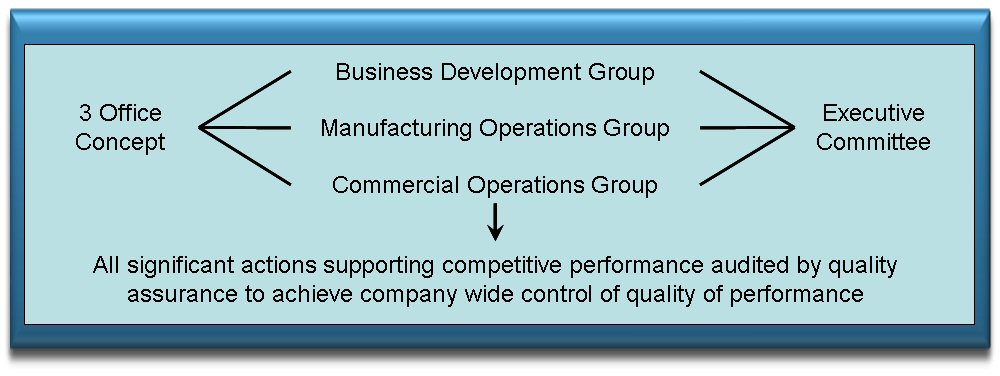4.09 - Total Quality Organization – Structure
The restructuring of manufacturing into cellular units makes necessary an examination of organisational structures, many of which are still based on highly specialised and fragmented functions. These traditional arrangements, which lead to over-specialised job titles, are difficult to integrate to create a common purpose. It must be recognised that what seemed appropriate yesterday may not be the best today, let alone tomorrow! To be successful we must move towards the creation of:-
The natural process group organisation through the ‘Single Office’ concept |
This involves the identification of the major cross functional processes of a traditional business and grouping them together for management purposes either physically or by reporting line to a cross functional manager or team leader.
The concept has evolved into the three office model in order suit the large organisational structures of the typical design and manufacture environment, (ie a single office for each natural group).

Functional Organisations
- Divide problems into unconnected pieces
- Self perpetuating
- Highly specialised and fragmented
- Each function has a fragment of a business process
- Slow to change due to functional problems and inertia
- Have difficulty solving cross-functional problems which leads to excessive paperwork
- Discourage lateral communications and responsibility
- Massage problems to fit the current organisation and exhibit parochialism
- Have general managers who are detail decision makers and have to work via traditional reporting line structures with many levels and fragmented departments.
Natural Organisations
- Perceive and handle the total problem as a whole within defined integrated major processes (e.g. New Product Introduction Process)
- Adjust resources and structure to meet the moment - flexible teams
- Deal with cross-functional problems as matter of routine
- Need comparatively little co-ordination
- Encourage lateral communications and responsibility
- Simple but effective communications within the process grouping
- Have general managers who are strategy oriented and decision makers and co-ordinate the major processes through cross-functional management of natural groups
A cross-functional process is an integrated set of activities carried out by people or machines and people. Some cross-functional processes are:-
Process |
Traditional Functions Employed |
New Product Introduction |
Marketing, Project Planning, Design, Manufacturing Systems Engineering |
Materials Control |
Purchasing, Inspection, QA, Stock Control, Distribution Logistics, Cell Capacity Planning, Tooling Design |
Cost Base Management |
Across each process |
These require policies, goals, targets, plans, missions, measures of performance and resources.
Important Organisational Design Features
- First identify the major processes that run through a business
- Simple integrated cellular group design with a minimum number of levels above cells and within them
- Broad job boundaries with reduced specialisation
- Skills levelling to simplify job structures into 4 groups and 3 levels
- Structure teams and job functions around material flows in manufacturing and information flows elsewhere
- Relevant measures of performance for all modules / cells / processes
- Pay structures which rewards performance and recognises training
- Operator responsibility is widened and supported by training
- Internal and external customer / supplier relationships
- An innovative self-motivated mix of operations and development functions ensuring adequate attention to both long and short term targets for competitiveness
- A multi-disciplinary team approach to problem definition and solutions to meet business priorities - permanent teams for cross-functional operational processes, temporary teams for development processes to solve problems
- High visibility feedback and communications
The Quality Assurance Role
Create a cross-functional Quality Council which will:
- Define priorities from a business perspective
- Develop a framework for a Total Quality programme
- Ensure adequate resources are available
- Communicate demonstrated best practice
- Demonstrate top management commitment
- Control project management processes
To achieve:-
- MISSIONS and PLANS
- Programme co-ordination and achievement of development targets
- Control of continuous improvement groups and schemes
- Co-ordinate multi-disciplinary taskforces
- Audits measures of performance for each cell or process